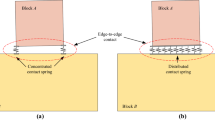Abstract
This paper extends the original 2D discontinuous deformation analysis (DDA) method proposed by Shi to 3D cases, and presents the formulations of the 3D DDA. The formulations maintain the characteristics of the original 2D DDA approach. Contacts between the blocks are detected by using Common-Plane (C-P) approach and the non-smooth contact, such as of vertex-to-vertex, vertex-to-edge and edge-to-edge types, can be handled easily based on the C-P method. The matrices of equilibrium equations have been given in detail for programming purposes. TheC program codes for the 3D DDA are developed. The ability and accuracy of the formulations and the program are verified by the analytical solutions of several dynamic examples. The robustness and versatility of the algorithms presented in this paper are demonstrated with the aid of an example of scattering of densely packed cubes. Finally, implications and future extensions are discussed.
Similar content being viewed by others
References
Goodman RE, Taylor RL, Brekke TL. A model for the mechanics of jointed rock.Journal of the soil mechanics and foundations division, ASCE, 1968, 94(SM3): 637–659
Crouch SL, Starfield AM. Boundary Element Method in Solid Mechanics. Allen and Unwin, 1983.
Shi GH, Goodman RE, Discontinuous deformation analysis. In: Dowding CH, Singh MM, eds. Proceedings of the 25th US Symposium on Rock Mechanics, New York: Society of Mining Engineers of AIME, 1984. 269–277
Shi GH, Goodman RE. Two-dimensional discontinuous deformation analysis.International Journal for Numerical and Analytical Methods in Geomechanics, 1985, 9: 541–556
Shi GH. Discontinuous deformation analysis: a new numerical model for the statics and dynamics of block systems. [PhD Thesis], Berkeley: University of California, 1988
Shi GH, Goodman RE. Generalization of two-dimensional discontinuous deformation analysis for forward modeling.International Journal for Numerical and Analytical Methods in Geomechanics, 1989, 13(4): 359–380
Shi GH. Discontinuous deformation analysis: a new numerical model for the statics and dynamics of deformable block structures.Engineering Computations. 1992, 9(2): 157–168
Cai YE, Liang GP, Shi GH, et al. Studying an impact problem by using LDDA method. In: Salami R, Banks D, eds. Proceedings of the 1st International Forum on Discontinuous Deformation Analysis (DDA) and Simulations of Discontinuous Media, Albuquerque: TSI Press, 1996. 288–294
Lin CT, Amadei B, Jung J, et al. Extensions of discontinous deformation analysis for jointed rock masses.International Journal of Rock Mechanics and Mining Science, 1996, 33(7): 671–694
Lin JS, Lee DH. Manifold method using polynomial basis function of any order. In: Salami R, Banks D, eds. Proceedings of the 1st International Forum on Discontinous Deformation Analysis (DDA) and Simulations of Discontinuous Media, Albuquerque: TSI Press, 1996. 365–372
Koo CY, Chern JC. The development of DDA with third order displacement function. In: Salami R, Banks D, eds. Proceedings of the 1st International Forum on Discontinuous Deformation Analysis (DDA) and Simulations of Discontinuous Media, Albuquerque: TSI Press, 1996. 342–349
Shyu KK. Nodal based discontinuous deformation analysis. [PhD Thesis]. Berkeley: University of California, 1993
Chang CT. Nonlinear dynamic discontinuous deformation analysis with finite element meshed block system. [PhD Thesis]. Berkeley: University of California, 1994
Al-Zahrani RM. A coupled displacement deformation analysis and boundary element method for twodimensional elastostatic problems. [PhD Thesis]. University of Pittsburgh, 2000
Kim YI, Amadei B, Pan E. Modeling the effect of water, excavation sequence and rock reinforcement with discontinuous deformation analysis.International Journal of Rock Mechanics and Mining Science, 1999, 36(7): 949–970
Yeung MR. Application of Shi's discontinuous deformation analysis to the study of rock behavior. [PhD Thesis]. Berkeley: University of California, 1991
Ke TC, Bray JD. Modeling of particulate media using discontinuous deformation analysis.Journal of Engineering Mechanics, 1995, 121(11): 1234–1243
Thomas PA, Bray JD, Ke TC. Discontinuous deformation analysis for soil mechanics. In: Salami R, Banks D, eds. Proceedings of the 1st International Forum on Discontinuous Deformation Analysis (DDA) and Simulations of Discontinuous Media. Albuquerque: TSI Press, 1996. 454–461
Thomas PA, Bray JD. Capturing nonspherical shape of granular media with disk clusters.Journal of Geotechnical and Geoenvironmental Engoneering, 1999, 125(3): 169–178
Maclaughlin MM. Discontinuous deformation analysis to the kinematics of landslides. [PhD Thesis]. Berkeley: University of California, 1997
Koo CY, Chern JC. Modification of the DDA method for rigid block problems.International Journal of Rock Mechanics and Mining Science, 1998, 35(6): 683–693
Shi GH. Three dimensional discontinuous deformation analysis. In: Elsworth D, Tinucci JP, Heasley KA, eds. Proceedings of the 38th US Rock Mechanics Symposium, Washington, DC, 2001. 1421–1428
Yeung MR, Jiang QH, Sun N. Validation of block theory and three-dimensional discontinuous deformation analysis as wedge stability analysis methods.International Journal of Rock Mechanics & Mining Sciences, 2003, 40(2): 265–275
Jang HI, Lee CI. Development of a three-dimensional discontinuous deformation analysis technique and its application to toppling failure. In: Hatzor YH, ed. Proceedings of the 5th International Conference on Analysis of Discontinuous Deformation. Abingdon, Balkema, 2002. 225–229
Shi GH. Simplex integration for manifold method. In: Salami R, Banks D, eds. Proceedings of the 1st International Forum on Discontinuous Deformation Analysis (DDA) and Simulations of Discontinuous Media, Albuquerque: TSI Press, 1996. 205–262
Cundall PA. Formulations of a three-dimensional distinct element model—Part I. A scheme to detect and represent contacts in s system composed of many polyhedral blocks.International Journal of Rock Mechanics and Mining Science, 1988, 25(3): 107–116
Taniguchi T. Non-linear response analyses of rectangular rigid bodies subjected to horizontal and vertical ground motion.Earthquake Engineering and Structural Dynamics, 2002, 31(8): 1481–1500
Author information
Authors and Affiliations
Additional information
The project supported by the National Natural Science Foundation of China (50139010)
Rights and permissions
About this article
Cite this article
Jun, L., Xianjing, K. & Gao, L. Formulations of the three-dimensional discontinuous deformation analysis method. Acta Mech Sinica 20, 270–282 (2004). https://doi.org/10.1007/BF02486719
Received:
Revised:
Issue Date:
DOI: https://doi.org/10.1007/BF02486719




